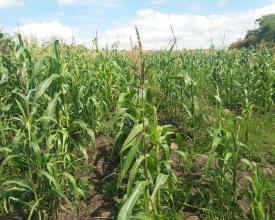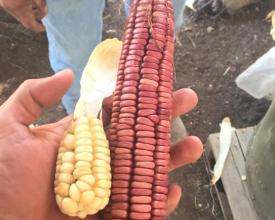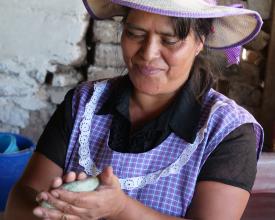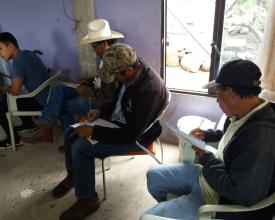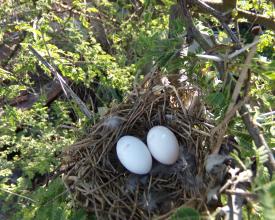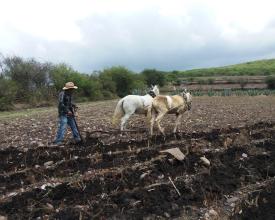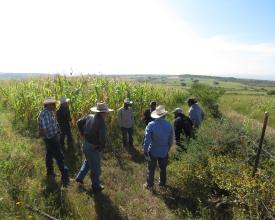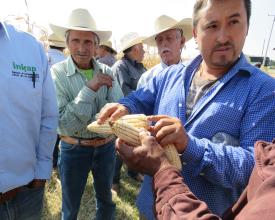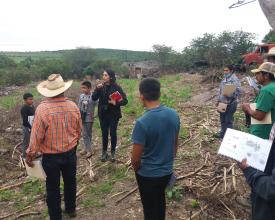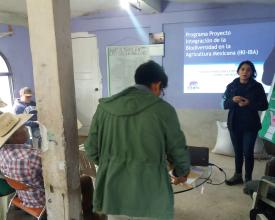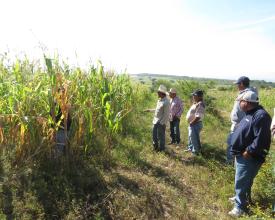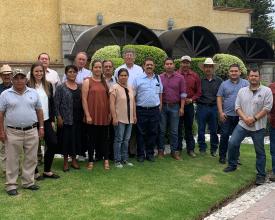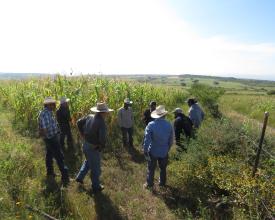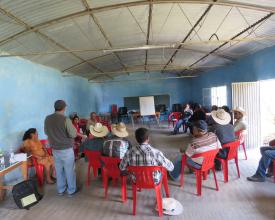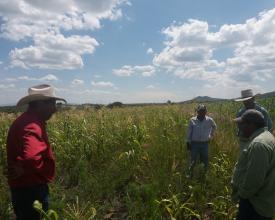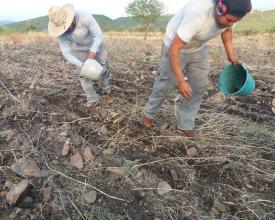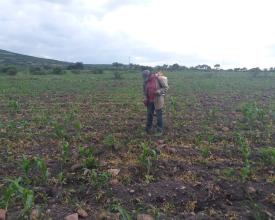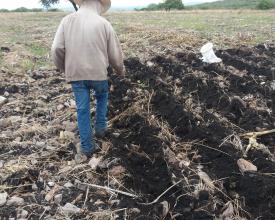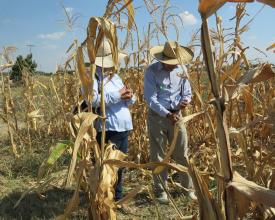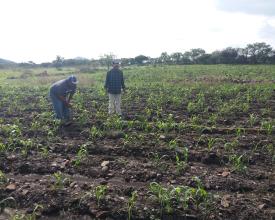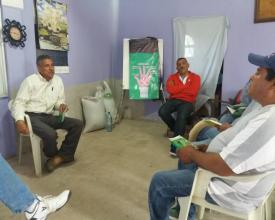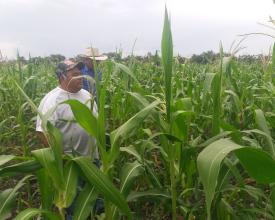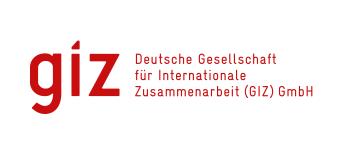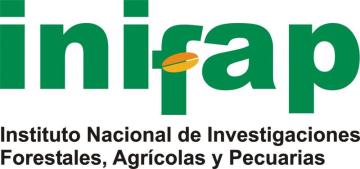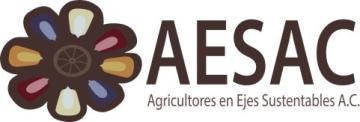
Conservation and Sustainable Use of Natural Resources for Agriculture in the Bajío Region of Guanajuato
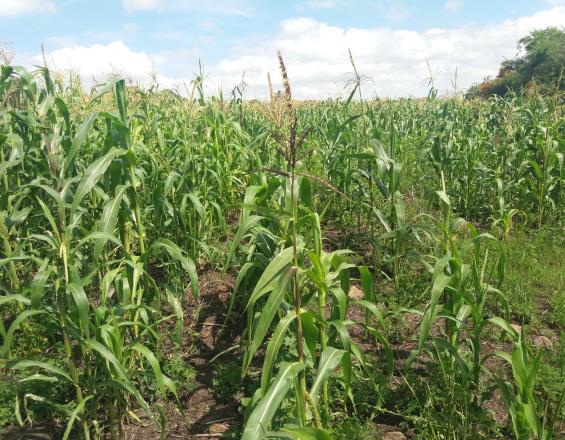
In Mexico, smallholder agriculture under rainfed conditions is no longer a viable alternative for most farming families due to low productivity and the high cost of inputs, resulting in high loss rates, low crop prices, migration, and the degradation of natural resources. In response to this problem, INIFAP researchers developed five technological components to help farmers reduce production costs and increase yields: a) Conservation tillage, b) Organic nutrition, c) Selection of their own seed, d) Ecological pest management, and e) Alternative methods for grain and seed storage.
The general objective of the project was to consolidate this sustainable agricultural production model by strengthening the social organization of the region's producers, as well as implementing and replicating the five sustainable axes model.
Context
Challenges addressed
Environmental
- Agriculture in Mexico has been inadequately managed in terms of soil and crop management, which, together with the excessive use of agrochemicals, has led to the disruption of natural cycles.
- Inadequate agricultural techniques cause a decrease in the amount of organic matter and the loss of soil structure, which reduces its water storage capacity and increases resistance to root penetration.
Economic
- For many years the agricultural sector has invested in subsidies or incentives that encourage practices that are detrimental to the services that biodiversity provides to production.
Social
- Smallholder agriculture under rainfed conditions is no longer a viable alternative for most farming families.
- Achieving sustainability implies a radical change in the way farmers think and act, substituting conventional methods for options that make it possible to restore balance to agroecosystems.
Location
Process
Summary of the process
Strengthening the organization in terms of plot protection, soil analysis, hermetic silos and much more, was of great help to increase production using sustainable practices. In the exchanges of experiences, the producers see that it is necessary to organize themselves in order to obtain faster and more profitable results.
The exchange of experiences among producers is often more efficient because they are people in similar economic conditions, which is not the case when the training takes place in sophisticated experimental field conditions. Experiments and changes are explained in terms and words of common use, in the language of daily use among farmers. This results in increased confidence: "if one of our people could do it, so can I".
In the trainings, the technician emphasizes that the experiences and knowledge of the producers are very important and that one must also be willing to experiment with different ways of doing things. When there are better results in production and an increase in the biodiversity associated with the plots, less economic investment and labor, the producers are convinced and advance socially in their attitudes.
Building Blocks
Technical Support
In 2013, the National System of Phytogenetic Resources for Food and Agriculture (SINAREFI) together with the National Institute of Forestry, Agricultural and Livestock Research (INIFAP) initiated a monthly training program for small producers in the community of Ojo Zarco, in the Municipality of Apaseo el Grande, Guanajuato. A community seed bank was organized and a group of producers who are custodians of criollo corn seeds was formed.
Initially, many producers attended the training sessions in the hope of receiving economic support, but when Dr. Aguirre of INIFAP proposed that each producer conduct experiments to learn about the best conditions for his plot, a group of the most interested producers in the area began to consolidate. The experiments compared the "traditional" sowing with the one that applied a change of practice, with respect to data on grain production and shearing. The results in the color and size of the plants encouraged the producers, but the results in productivity were decisive.
The training process is very slow but effective in the semiarid rainfed agriculture zone. It takes 6 to 7 years to obtain good results when only small farmers have their own resources.
Enabling factors
- The training program carried out by SINAREFI and INIFAP allowed producers to understand the importance of the 5 Axes. Although the program did not last more than 3 years, the producers were able to continue replicating the good practices learned.
- The associative capacity of small producers and their ability to experiment on their own plots.
- The involvement of young people from the community in monitoring actions.
Lesson learned
- The use of digital tools has been fundamental for the good implementation of cooperative projects, but even more so for not stopping activities during the pandemic period.
- The continuous technical accompaniment of INIFAP personnel gave a very important support to the development of the 5 axes of sustainability that now make up the production model adopted by the producers of Apaseo el Grande.
Strengthening of social organization
The group of producers interested in continuing to implement the sustainable production practices they had learned, sought to organize themselves in a more formal way, understanding that together they could access more support and have their own personality before different institutions.
With support from GIZ, they formed a Civil Association called Agricultores en Ejes Sustentables A.C. (AESAC), which is an organization run entirely by the producers of Apaseo el Grande. In addition to the development and consolidation of the producers' technical capacities, AESAC contemplates the development of administrative and management capacities. This action seeks to generate in the producers the necessary managerial skills to achieve efficient administration, as well as the skills to achieve financial sustainability of the organization and future access to public and private resources to continue and improve the production model for the benefit of the producers and biodiversity.
Enabling factors
- There was an awareness and interest in the group of producers to formalize their efforts in an organization that could obtain financing.
- The formalization of the Association allowed its registration with the Treasury office and this made it possible to obtain a bank account.
- The training and constant advice from the GIZ management team was indispensable to advance the project, both for the acquisition of goods and for the verification of expenses.
Lesson learned
- It is always necessary for AESAC's partners to contribute resources and manpower to make the most of the support they receive.
- These types of projects are long term and few governments and institutions are willing to participate, so it is the interest of the partners that keeps the work going.
- The partners have learned to recognize their mistakes and to face the challenges of creating a grassroots organization. This is not the case in many farming communities.
Promotion of farmer experimentation
INIFAP technicians and other organizations have accompanied Apaseo el Grande producers for many years, training them and encouraging them to seek their own solutions to the particular problems of their plots.
Over time, the growers learned that their plots have particular needs depending on their location, soil type, climate conditions, among other things, and that the "recipes" they sometimes find in books do not always work the same for everyone. This motivated them to continue experimenting with different practices within the five axes of sustainability they had learned, and to write down the combinations that gave them better production yields at lower cost. This has been at the heart of the AESAC experience.
They also learned to share their experiences and give recommendations to other producers who were resistant to change, and were able to organize training workshops even in other communities.
Enabling factors
- The good relationship of the producers with the technicians who accompany them, together with their openness to allow them to seek their own solutions instead of pigeonholing them into orthodoxy.
- The courage of the producers to try methods not previously known to them, at the risk of reducing their profits when the results were not as expected.
- The demonstration that the method works: in a year of severe drought, AESAC members obtained higher yields than their neighbors, which soon attracted more interested producers.
Lesson learned
- Being able to demonstrate that everyone has much to contribute to the process of sustainable axes gives a great value of self-esteem to AESAC producers.
- It is important to understand that environmental conditions, soils and management are very different among all producers, which results in different production data.
Peer-to-peer exchange of experiences
One of AESAC's first objectives as an organization was to promote the replicability of its sustainable production model by supporting the training of other producer groups in the Bajío region. The workshops provided by its members had a very important multiplier effect when other producers in the region felt identified and felt more confident in sharing their experiences and asking their questions. The members' plots functioned as demonstration plots, where they could show the results of the practices implemented and thus motivate other producers to initiate processes of improvement and conditioning of their productive areas.
Enabling factors
- The trainings are held in nearby communities, which provides an atmosphere of trust and cordiality.
- AESAC redesigned a manual prepared by INIFAP on the 5 axes of sustainability, which allowed us to have a simpler manual, with less text and more graphics, which was more understandable and attractive to producers.
Lesson learned
- The fact that the training and exchange of experiences is conducted by producers greatly facilitates communication and confidence to experiment with new practices in their fields.
- The type of best practice examples used by AESAC producers seem clear and logical to the producers being trained.
- The project also taught AESAC partners how to document and formalize training sessions with their peers as part of their management capacity building.
Impacts
- Consolidation and strengthening of social organization through the development of administrative and technical capacities.
- Increased crop diversity, soil fertility, implementation of eco-techniques, use of organic fertilizers and pest management.
- Replicability of practices to other producer groups in the region.
- Exchange of experiences and training among producers (Training of Trainers).
- Monitoring: Inventory of corn breeds and other species used by producers, monitoring of indicator species of birds and pollinators, as well as soil monitoring.
- Strengthening of the value chain: exchange of experiences and workshops with groups with varying degrees of progress.
- Alternative and sustainable medicine.
- Water harvesting.
Beneficiaries
- Producers who participate as members of AESAC.
- Producers in the region who are not AESAC members but receive training from AESAC.
- Women and their families, who enjoy better health and nutrition.
Sustainable Development Goals
Story
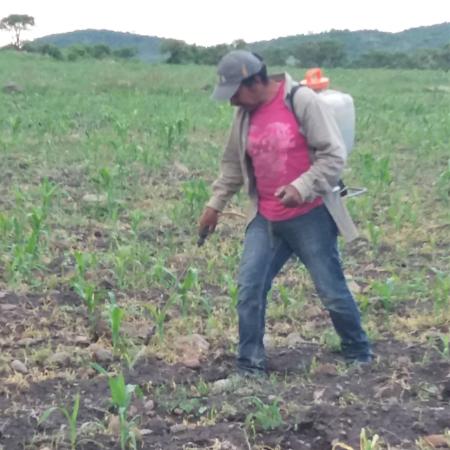
My 80-year-old father scolded me for being a lazy farmer, because I didn't weed or weed the plot he gave me. He used to tell me that I was a "plain breaker", planting without good soil preparation. And this was because I began to use the techniques we were taught to protect the soil and the sowing. I open the furrow to sow with my team of horses. My son sows and then covers the seed quickly with a branch harrow, we don't use a tractor. I used to harvest 300 to 500 kilos of corn per hectare and buy fifty bales of stubble every year. Now I harvest 3 to 5 tons of corn per hectare (depending on the amount of rainfall at the right times for the crop) and I don't buy any stubble, I even have some left over pasture.
Because of his age, my father employs laborers to fallow, cut furrows, sow, throw fertilizer, weed, all with a team of horses and then apply herbicide with a backpack. He invests 16,000 pesos (MXN) in a hectare because he has children in the United States who send him remittances, Pro Campo and receives support from the elderly. But he doesn't do the math and when he harvests he doesn't even collect a quarter of his investment. Two of my brothers did more or less the same.
After seeing my harvest, my father said to me, "Oh son, how do you do it?" I explained to him that you have to train yourself and change little by little. He didn't even want to change. One of my brothers with his wife and daughter took several trainings and are experimenting with different practices and foliar application.
I don't lose hope that one day my dad and my other siblings will decide to change. I know that it hurts us to change because in our culture we are made fun of and worse when things don't work out the first time. Neighbors of my plot and others start asking me how I do it, and I explain in my words what changes I am making and why I have no problems with insect pests. I tell them that as long as the plants are well nourished it has a "trophobiosis" effect. I learned to live with biodiversity.
There are always those who criticize me, but I do not pay attention to them because you have to be constant and have patience to let nature and biodiversity resume their process, to produce more with less work and costs.
Octavio Rojas Espinoza, AESAC member from Obraje de Ixtla, Municipality of Apaseo el Grande, Guanajuato, Mexico.

